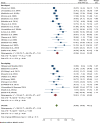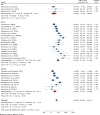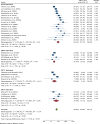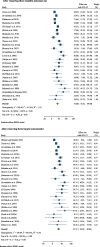Sero-prevalence of hepatitis viral infections among sanitary workers across worldwide: a systematic review and meta-analysis
- PMID: 37312028
- PMCID: PMC10265919
- DOI: 10.1186/s12879-023-08354-1
Sero-prevalence of hepatitis viral infections among sanitary workers across worldwide: a systematic review and meta-analysis
Abstract
Background: Sanitation or sanitary workers are exposed to hepatitis virus infections because of filthy and dangerous working conditions. The current global systematic review and meta-analysis aimed to estimate the pooled sero-prevalence of occupationally associated hepatitis virus infection among them.
Methods: Preferred Reporting Items for Systematic Reviews (PRISMA), and Population, Intervention, Comparison, Outcome and study design (PICOS) were used for flow diagram, and review questions, respectively. Four databases other methods were used published articles from 2000 to 2022. Boolean logic (AND, OR), MeSH, and keywords were used: (Occupation *OR Job *OR Work) AND (Hepatitis A *OR Hepatitis B virus *OR Hepatitis C virus *OR Hepatitis E virus) AND (Solid waste collectors [SWCs] *OR Street sweepers [SS] *OR Sewage workers [STWs] *OR health care facilities cleaners [HCFCs)) AND (Countries). Stata MP/17 software was used for pooled prevalence analysis, meta-regression analysis (Hedges) at a 95% confidence interval (CI:95%).
Results: A total of 182 studies were identified studies, a total of 28 studies were included from twelve countries. Of these, from developed (n = 7) and developing countries (n = 5). From total a of 9049 sanitary workers, 5951(66%), 2280 (25%) and 818 (9%) were STWs, SWCs and SS, respectively. Globally, the pooled sero-prevalence of occupational-related hepatitis viral infections among sanitary workers was 38.06% (95% CI: 30-0.46.12). Of this, it was 42.96% (95% CI: 32.63-53.29) and 29.81% (95% CI: 17.59-42.02) for high-income and low-income countries, respectively. Meanwhile, by sub-analysis, the highest pooled sero-prevalence of hepatitis viral infections by categories, type and year were 47.66% (95%CI: 37.42-57.90), 48.45% (95% CI: 37.95-58.96), and 48.30% (95% CI: 36.13-60.47) for SWTs, HAV, and 2000 to 2010 year, respectively.
Conclusion: The consistency of the evidence suggests that sanitation workers, particularly sewage workers, are susceptible to occupationally acquired hepatitis regardless of their working conditions, necessitating significant changes to occupational health and safety regulations from governmental policies and other initiatives to reduce risks among sanitary workers.
Keywords: Hepatitis Virus; Infections; Occupation; Sanitary workers; Worldwide.
© 2023. The Author(s).
Conflict of interest statement
Not applicable.
Figures







Similar articles
-
Global prevalence of occupational injuries among sanitation workers: a systematic review and meta-analysis.Front Public Health. 2024 Oct 3;12:1425904. doi: 10.3389/fpubh.2024.1425904. eCollection 2024. Front Public Health. 2024. PMID: 39421826 Free PMC article.
-
Occupation-related respiratory diseases among sanitary workers in the workplace: a systematic review and meta-analysis.Front Public Health. 2024 Nov 26;12:1501768. doi: 10.3389/fpubh.2024.1501768. eCollection 2024. Front Public Health. 2024. PMID: 39659714 Free PMC article.
-
Global systematic review of occupational health and safety outcomes among sanitation and hygiene workers.Front Public Health. 2023 Dec 19;11:1304977. doi: 10.3389/fpubh.2023.1304977. eCollection 2023. Front Public Health. 2023. PMID: 38174086 Free PMC article.
-
Global prevalence of musculoskeletal disorders among sanitary workers: a systematic review and meta-analysis.Int J Occup Saf Ergon. 2024 Mar;30(1):238-251. doi: 10.1080/10803548.2023.2293390. Epub 2024 Jan 1. Int J Occup Saf Ergon. 2024. PMID: 38083826
-
Occupational respiratory symptoms and associated factors among street sweepers in low- and middle-income countries: A systematic review and meta-analysis.PLoS One. 2025 Apr 9;20(4):e0320237. doi: 10.1371/journal.pone.0320237. eCollection 2025. PLoS One. 2025. PMID: 40202984 Free PMC article.
References
-
- Kabir, A., N. Farhana, F. Akter, S. Jesmin, A. Ali. Sweeping practices, knowledge about OSH hazards in Dhaka city, Bangladesh:. Aa qualitative inquiry, 2015. 2(3): 237–243. 10.18203/2394-6040.ijcmph20150476:
-
- WHO. /World Health Organization/ New report exposes horror of working conditions for millions of sanitation workers in the developing world. 2019.
-
- Gomathi P, Kamala K. Threatening health impacts and challenging life of sanitary workers. J Evol Med Dent Sci. 2020;9(41):3061.
-
- WHO/World Health Organization/. Health, Safety and Dignity of Sanitation Workers: an Initial Assessment. Guidelines on sanitation and health, Geneva, 2018. 2020, World Health Organization: Geneva. https://www.ilo.org/wcmsp5/groups/public/---ed_dialogue/---sector/docume.... Accessed 3 May 2022
Publication types
MeSH terms
Substances
LinkOut - more resources
Full Text Sources
Medical

